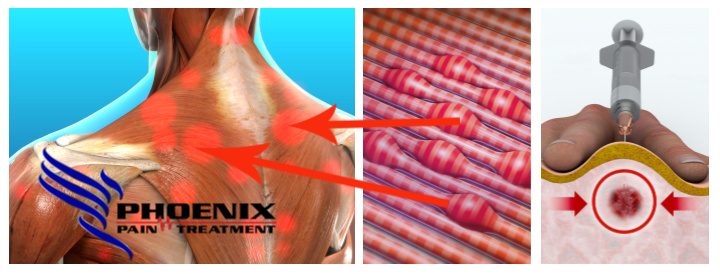
Trigger Point Injections

Trigger Point Injections
At Phoenix Pain Treatment our clinicians specifically examine for trigger points which can cause pain and suffering. In this article we hope to shine some light on how actively treating your trigger points will decrease your pain, allowing the affected muscles to relax and help to heal your injuries. A trigger point is a small but highly concentrated muscle spasm which can actually be felt as a small lump or nodule. Pushing on this nodule typically produces pain that can be quite intense. Trigger points can exist in any muscle in your body. More often than not there will be several trigger points in the same muscle or muscles that over lap one another.
Typically following auto accident trauma, especially whiplash injury trigger points can be found on both sides of your body. In the case of whiplash, they can be found in the neck muscles as well as the muscles that connect to the neck from the shoulders. Trigger point cause your muscles to fire and spasm and a muscle that is in spasm is in a weakened state and therefore is not functioning properly. Restricting the muscles range of motion. Trigger point typically cause pain but sometimes are not painful until pressed on. Trigger point pain will refer to different area of your muscles. This is called referred pain and referred pain can make diagnosing and managing trigger points difficult. Referred pain typically follows certain patterns that are well documented. Let’s take a closer look at the trigger point. The trigger points can be palpated by the trained physician, but you have to know what you are looking for in order to find it. That is why we place trigger points in the “Underlying or hidden Injuries” category.
To understand how these seemingly tiny nodules can affect the entire functional capacity of your muscles we have to discuss some anatomy. So think of a muscle as a group of bundles of straws and each straw is wrapped in plastic cling wrap. Then take 2 or 3 or those individual straws and wrap them in plastic wrap. Now do this several times. So each straw is now called a Sarcomere and the plastic wrap is now protecting and connecting the Sarcomeres. Now let’s add blood vessels like arteries and veins and of course your nerves.
So a trigger point would form between the Sarcomere (the straw) and the protective coating (The plastic wrap) which added all together makes up your muscle. In this environment everything is very neatly packaged, and the trigger point causes your anatomy to change and it irritates the Sarcomere and their coverings and causes the nerves to fire giving you pain. When your doctor palpates (or feels) the trigger point immediate referral of pain occurs.
The trigger points cause the micro anatomy of your muscles (Sarcomeres) to stay in a spastic state giving off pain signals to your brain and your brain in turn tells the muscle to shut down. It is really a cascade of decreased oxygen, nutrient starvation and waste product builds up because everything is just not functioning correctly. It gets even worse as the trigger point continues your muscle actually shorten and can become even tighter and more painful. More often than not trigger points will not just go away on their own.
The first line of management of trigger points is to massage the trigger points in order to help them release. This can be very painful for the accident victim to endure. The idea is to massage the trigger point area to increase blood flow and with that comes increased oxygen and nutrition and hopefully getting the waste products to move out of the area.
When this does not occur our Chiropractic physicians will refer out for Trigger Point injections. The idea is to get the trigger point to release and sometimes this takes a concerted effort for both chiropractic and interventional pain management to get the trigger points to release. So the interventional pain medical doctor injects the trigger point with anti-inflammatory and pain relieving medications. Don’t worry injection uses a very tiny needle and is not very painful at all. There is typically immediate decrease of pain and tightness. You would then go back to your conservative physical medicine delivered by your chiropractor. Trigger points will require 1-2 injections.
If you or a loved one have been involved in an auto accident it is likely that you may have trigger points in the muscles surrounding the affected area. Give us a call today.

Call Now Phoenix Pain Treatment 602-449-9430